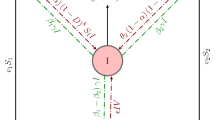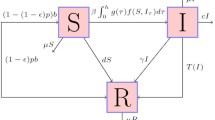Abstract
With the consideration of mechanism of prevention and control for the spread of infectious diseases, we propose, in this paper, a state dependent pulse vaccination and medication control strategy for a SIRS type epidemic dynamic system. The sufficient conditions on the existence and orbital stability of positive order-1 or order-2 periodic solution are presented. Numerical simulations are carried out to illustrate the main results and compare numerically the state dependent vaccination strategy and the fixed time pulse vaccination strategy.







Similar content being viewed by others
References
Agur, Z., Cojocaru, L., Anderson, R., & Danon, Y. (1983). Pulse mass measles vaccination across age cohorts. Proc. Natl. Acad. Sci. USA, 90, 11698–11702.
Anderson, R. M., & May, R. M. (1979). Population biology of infectious diseases: part I. Nature, 280, 361–367.
Anderson, R. M., & May, R. M. (1991). Infectious diseases of humans: dynamics and control. Oxford: Oxford University Press.
Capasso, V. (1993). Lecture notes in biomathematics: Vol. 97. Mathematical structures of epidemic systems. New York: Springer.
Diekmann, O., & Heesterbeek, J. A. P. (2000). Mathematical epidemiology of infectious diseases: model building, analysis and interpretation. New York: Wiley.
D’Onofrio, A. (2002). Stability properties of pulse vaccination strategy in SEIR epidemic model. Math. Biosci., 179, 57–72.
Gao, S. J., Chen, L. S., Nieoto, J. J., & Torres, A. (2006). Analysis of a delayed epidemic model with pulse vaccination and saturation incidence. Vaccine, 24, 6037–6045.
Gao, S. J., Chen, L. S., & Teng, Z. D. (2007). Impulsive vaccination of an SEIRS model with time delay and varying total population size. Bull. Math. Biol., 69, 731–745.
Gao, S. J., Liu, Y. J., Nieto, J. J., & Andrade, H. (2011). Seasonality and mixed vaccination strategy in an epidemic model with vertical transmission. Math. Comput. Simul., 81, 1855–1868.
Hale, J., & Kocak, H. (1991). Dynamics and bifurcations. New York: Springer.
Hethcote, H. W. (1989). Three basic epidemiological models. In Applied mathematical ecology, Berlin: Springer.
Jiang, G. R., & Lu, Q. S. (2006). The dynamics of a prey–predator model with impulsive state feedback control. Discrete Contin. Dyn. Syst., Ser. B, 6, 1310–1320.
Jiang, G. R., & Lu, Q. S. (2007). Impulsive state feedback control of a predator–prey model. J. Comput. Appl. Math., 200, 193–207.
Kermack, W. O., & Mckendrick, A. G. (1927). Contribution to the mathematical theory of epidemics. Proc. R. Soc. Lond. Ser. A, 115, 700–721.
Lakshmikantham, V., Bainov, D. D., & Simeonov, P. S. (1989). Theory of impulsive differential equations. Singapore: World Scientific.
Liu, S. Y., Pei, Y. Z., Li, C. G., & Chen, L. S. (2009). Three kinds of TVS in a SIR epidemic model with saturated infectious force and vertical transmission. Appl. Math. Model., 33, 1923–1932.
Ma, Z. E., Zhou, Y. C., Wang, W. D., & Jin, Z. (2004). Mathematical modelling and research of epidemic dynamical systems. Beijing: Science Press (in Chinese).
Nie, L. F., Teng, Z. D., Hu, L., & Peng, J. G. (2009). The dynamics of a Lotka–Volterra predator–prey model with state dependent impulsive harvest for predator. Biosystems, 98, 67–72.
Nie, L. F., Teng, Z. D., Hu, L., & Peng, J. G. (2010). Qualitative analysis of a modified Leslie–Gower and Holling-type II predator–prey model with state dependent impulsive effects. Nonlinear Anal., Real World Appl., 11, 1364–1373.
Pei, Y. Z., Liu, S. Y., Li, C. G., & Chen, L. S. (2009). The dynamics of an impulsive delay SI model with variable coefficients. Appl. Math. Model., 33, 2766–2776.
Ramsay, M., Gay, N., & Miller, E. (1994). The epidemiology of measles in England and Wales: rationale for 1994 national vaccination campaign. Commun. Dis. Rep., 4, 141–146.
Ross, R. (1911). The prevention of malaria (2nd ed.). London: Murray.
Ruan, S. G., & Wang, W. D. (2003). Dynamical behavior of an epidemic model with nonlinear incidence rate. J. Differ. Equ., 188, 135–163.
Sabin, A. B. (1991). Measles: killer of millions in developing countries: strategies of elimination and continuing control. Eur. J. Epidemiol., 7, 1–22.
Shulgin, B., Stone, L., & Agur, Z. (1998). Pulse vaccination strategy in the SIR epidemic model. Bull. Math. Biol., 60, 1–26.
Simeonov, P. S., & Bainov, D. D. (1988). Orbital stability of periodic solutions of autonomous systems with impulse effect. Int. J. Syst. Sci., 19, 2561–2585.
Tang, S. Y., Xiao, Y. N., Chen, L. S., & Cheke, R. A. (2005). Integrated pest management models and their dynamical behaviour. Bull. Math. Biol., 67, 115–135.
Terry, A. J. (2010). Pulse vaccination strategies in a metapopulation SIR model. Math. Biosci. Eng., 7, 455–477.
Wang, L. M., Chen, L. S., & Nieto, J. J. (2010). The dynamics of an epidemic model for pest control with impulsive effect. Nonlinear Anal., Real World Appl., 11, 1374–1386.
Acknowledgements
The authors would like to thank antonymous referees for their constructive suggestions and comments that improve substantially the original manuscript.
This work was supported in part by the Natural Science Foundation of Xinjiang (Grant No. 2011211B08), the National Natural Science Foundation of China (Grant No. 11001235, 11271312, and 11261056), the China Postdoctoral Science Foundation (Grant No. 20110491750 and 2012T50836), the Scientific Research Programmes of Colleges in Xinjiang (Grant No. XJEDU2011S08), the National Basic Research Program of China (2011CB808002), and the National Research Foundation of South Africa.
Author information
Authors and Affiliations
Corresponding author
Rights and permissions
About this article
Cite this article
Nie, LF., Teng, ZD. & Guo, BZ. A State Dependent Pulse Control Strategy for a SIRS Epidemic System. Bull Math Biol 75, 1697–1715 (2013). https://doi.org/10.1007/s11538-013-9865-y
Received:
Accepted:
Published:
Issue Date:
DOI: https://doi.org/10.1007/s11538-013-9865-y




